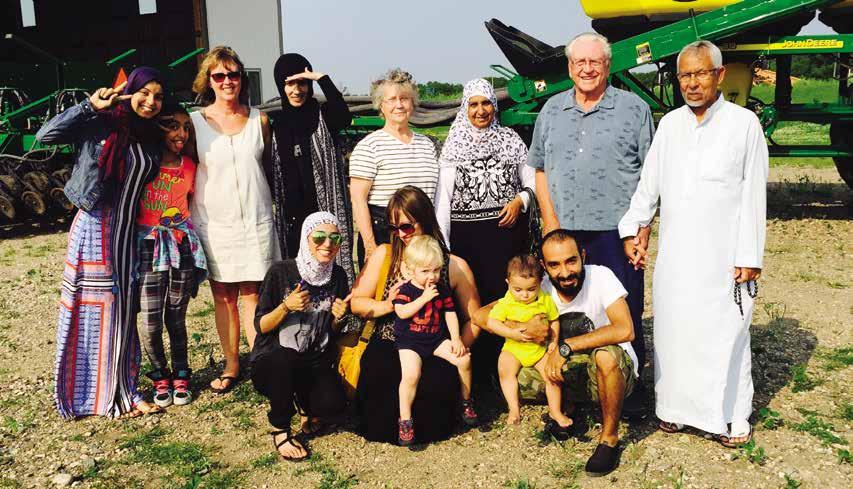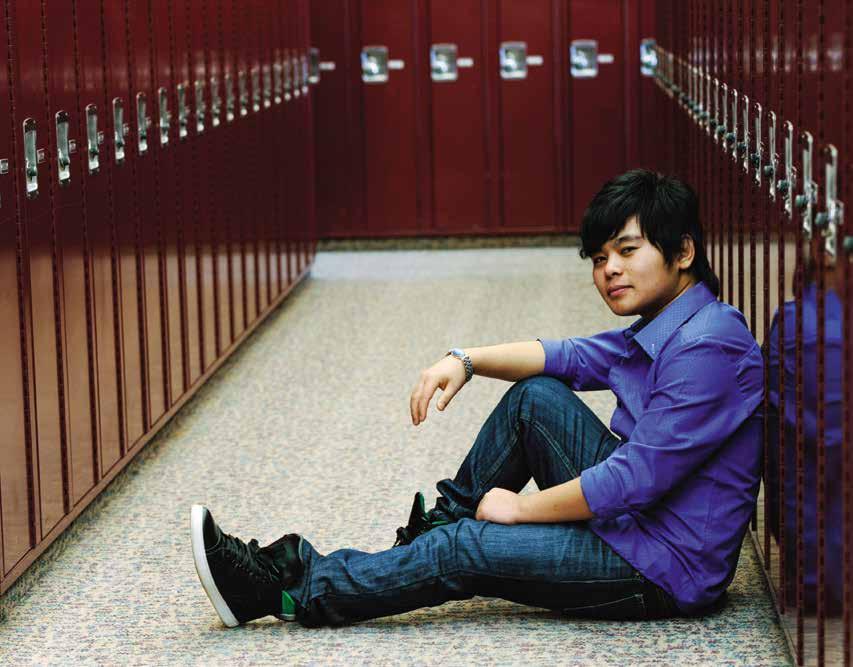
15 minute read
The Silent Narratives: African Refugee Women and their Integration Stories
by Jonix Owino
*Certain identifying details have been removed to protect the anonymity of the research subjects.
Advertisement
My village was attacked on the day war started in my country. My husband was killed. I had to take the kids very quickly and start running away. For many days we’re running and hiding. People were fighting and fighting and you know I had many kids so it was very difficult for escape. I thank God because I don’t know how we made it to the refugee camp in [African country].* We used to travel at night and hide in the forest during the day. The war was targeting the people from my tribe, [tribe name]. When we arrived at the refugee camp, it was very crowded. There was no clean water to drink and so many people were dying from diarrhea and many children had malaria. The environment was too small for the people. The food was being measured in small amount to make sure everybody gets little something to eat. One of my kids died in the camp. I lived in the refugee camp for eight years before coming here.
This is but one of the many heartrending background experiences of African Refugee Women (ARW) prior to their transition to the United States. In my recently concluded research study on “Integration of African Refugee Women into the Fargo-Moorhead Community,” the women shared their past experiences as well as stories of their integration into Fargo-Moorhead. I engaged in in-depth interviews with ten African refugee women ages forty and above from Congo, Somalia, South Sudan, Sudan, Liberia, and Rwanda who are currently residing in Fargo, North Dakota, or Moorhead, Minnesota. The women possessed unique characteristics in terms of their length of stay in the United States, marital status, religious affiliations, number of children, and cultural practices. Drawing from the research study, I bring to light the background experiences of the ARW; how the women perceive, understand, and relate to the Fargo-Moorhead community; and also some of the integration challenges shared by the ARW during the interview process, such as social isolation, the local (non-refugee) population generalizing the experiences and cultural origins of ARW, and social exclusion.
BACKGROUND EXPERIENCES
The term “refugee” carries with it several connotations, and it is understood and described differently by various individuals. The United Nations High Commissioner for Refugees (UNHCR) in 1967 described a refugee as a person who is outside his or her home country, or if he or she has no home country, then outside of the country in which he or she last habitually resided, and who is unable or unwilling to return to his or her country of nationality because of persecution or well-founded fear of persecution based on the person’s race, religion, nationality, membership in a particular social group, or political opinion. Most ARW flee from their home countries due to civil unrest, war, forced migration, and/or fear of being persecuted, and, in search of a safe haven, they migrate to neighboring/ bordering countries within Africa, where they reside in refugee camps. Life in the camps is not easy, as one of the women explained in the above narrative. The refugees flee from their homelands with very little or no clothes or other types of resources. They become severely limited in their options for survival, particularly in the camps, where they have little or no access to work, agricultural or grazing land, or other means of self-sufficiency. With no choice, they become totally dependent on humanitarian and international aid from organizations such as the Red Cross, which provides housing in the form of tents, and the World Food Program. Unable to go back to their home countries, many refugees remain in exile for several years and even decades until the UNHCR intervenes for relocation to western countries.
The difficult life experienced by ARW poses psychological challenges to their well-being, including experiences of grief and loss of loved ones, torture, unpreparedness during departure, disruption of education, and post-traumatic stress issues. The women I interviewed explained that it was after they arrived and settled into the new community that the memories of what they had experienced began to unfold. Mourning for their loved ones had been short-lived, because they had to be on the go and were also distracted by the challenging and problematic situations they were already encountering. A deep sense of sadness gripped their hearts as they remembered family members and friends who continue to endure the harsh life in the camps to date. One of the women mentioned:
All of the women in my study named close family members, relatives, or friends who are still in the refugee camps or still living among conflict in their home countries. The refugees who came to Fargo escaped the conflict but are haunted by their past and their families’ ongoing challenges.
LIFE IN FARGO-MOORHEAD
When I asked the women how they relate to and understand the Fargo-Moorhead community, they were quick to affirm that the community was a safe haven for them. They considered it peaceful and secure compared to the areas they had lived in in Africa prior to their transition to the United States. They emphasized that the environment was conducive for them, as well as for their children, who could now pursue education without interruption. One of the women mentioned:
Similar sentiments were echoed by another participant, who stated:
Fires in the camps were a concern for the women, as they would affect numerous tents that are closely connected and also contribute to several deaths, especially if they occurred at night.
The living standards in the Fargo-Moorhead community did not go without notice as the women narrated their integration experiences. In comparison to the lives they had in their countries of origin, ARW considered life to be expensive and vary depending on the seasons. This was attested to by comments such as:
Despite the high costs of living, seven of the women in the study were quick to appreciate the availability of electricity as well as other amenities and applauded their advantages.
INTEGRATION CHALLENGES
The African refugee women’s narratives revealed various challenges encountered in their integration into the Fargo-Moorhead community. The women perceived integration in terms of the level at which they participated in various activities within the community. Local integration is the ability of the refugee to participate with relative freedom in the economic and communal life of the host region, including cultural and political participation, legal rights, and full self-sufficiency. In comparing the Fargo-Moorhead community to the communities back in Africa, the women spoke of their countries as placing value on the community rather than on an individual. Members of traditional African societies experience a collective consciousness that is absolute, as well as a collective type of personality in which the component individuals are completely fused, dissolved, and highly integrated. On the other hand, the ARW considered the FargoMoorhead area as a place where everyone lived for themselves and by themselves. Refugees who had experienced close communal and family ties in their own culture experienced social isolation in Fargo-Moorhead and found the lack of a local strong community to be alienating.
Some of the women felt detached and withdrawn from the community because their contact with members of the community is very minimal. The shift in coming from a community that highly values community ties to one that has greater focus on individuality is hard to accommodate, and thus poses a challenge in the integration process. One woman emphasized this by mentioning:
This feeling is aggravated when one lacks companionship in terms of family or friends. If these ARW perceive a foreclosure from community structures and institutions because they cannot find meaningful connections with local community members, it makes sense that their day-to-day experiences are filled with loneliness. Similarly, the feelings of sadness they experience are exacerbated by their feelings of loneliness.
One of the barriers to successful integration that emerged was that cultural diversity among the African refugee women is overlooked in most cases, and the African women are categorized as if they all share similar cultural experiences, beliefs, and ways of life. The participants emphasized the importance of their new community to pay attention to their diverse cultures of origin and ways of life. Universal categorization of women in non-western countries, such as those located in Africa, is mostly done through constructed monolithic terms and classifications that overlook their diversity and heterogeneity. As much as the ARW come from the same continent, they are endowed with different ideologies and approaches to life that are contingent on culture, history, and geography. Their cultural practices vary from country to country and even among individuals of the same country, as there exists among the ARW other subcultures dependent on tribe, religion, region, or ethnic background. This was revealed through statements like:
Eight women in the study asserted that they did not appreciate the tendency of the local community members to generalize the experiences and practices of refugees. It is important to them that the existing diversity among groups be accorded due recognition. In providing clarification, the women discussed affirming cultural differences among themselves despite coming from the same continent.
Overlooking one’s beliefs or carrying out activities without providing explanations or acknowledging differing cultures within the African sphere creates misunderstandings and feelings of disrespect and infringes on relationships, thereby causing some women to shy away from gatherings. However, it is important to note that there are instances, depending on the nature of the activities or gatherings, where the women from Africa unite as a whole.
SOCIAL EXCLUSION
Social exclusion emerged in the study as the ARW described the challenges they experience as they integrate into the community. Social exclusion is the inability to participate in the normal relationships and activities available to the majority of people in a society, whether in economic, social, cultural, or political arenas. It denies individuals the capability to exercise the personal agency of participating and contributing to different aspects of society and can only be judged by comparing the (non) participation of some individuals or groups relative to others, in a given place and at a given time. Successful settlement of ARW depends on their social inclusion rather than exclusion. Social exclusion experiences pose an additional burden acting against ARW in their efforts to integrate. Social exclusion is a dynamic process, and its study involves examination of interrelationships across time and place, focus on the way host societies may exclude refugees from participation (not necessarily intentionally), and how systems need to adapt to ensure people are included.
In describing social exclusion, the ARW spoke of low English proficiency and transportation problems as factors that contribute to their exclusion and present obstacles to successful integration. Being able to speak the main language of the host community is central to the integration process. Not being able to speak English in the United States becomes a barrier to social interaction, economic integration, and full participation in the community. Inability to communicate comprehensively and adequately with Fargo-Moorhead locals made the women feel excluded, and some of them shied away from community endeavors. The women showed interest in wanting to learn, and some are learning English.
Some of the women, however, wondered what would be considered English fluency:
It was a concern for the women that after being in the community for a long time and perceiving themselves as being better in English, this improvement was not noticed or did not even appear to be recognized when they were interviewing for jobs or communicating with potential employers. Their distress posed the question: How good must their English be to be good enough?
In exploring social exclusion, lack of (and limited) transportation leads to the ARW opting out of community programs. The women mentioned transportation problems as another significant challenge to community involvement. The primary mode of transportation in the FargoMoorhead area is a car, and not having a car creates challenges in getting around the community. One woman mentioned:
The women’s desire to interact becomes restricted with limited means of transportation, thus furthering their social exclusion. Some of the women mentioned the difficulties associated with having a car, as well as problems with limited metro bus routes that restrict their movements.
CONCLUSION
By revealing their individual experiences, ARW draw attention to their diverse and unique situations. This is essential in debunking stereotypes in the community that emerge through generalizing and categorizing ARW as a single entity. During the course of the research study, I interacted with several locals of the FargoMoorhead area with a desire to learn how much familiarity they had with the refugee population. Eight out of ten of the individuals I engaged in conversation had very minimal knowledge on the specifics that constitute refugee status. This in itself reinforces the experiences of the ARW in the research study. There seem to be misunderstandings about who refugees are, what it means to be a refugee, and how they enter the community. This makes understanding the isolated experiences of ARW even more challenging, for the community must make efforts to reach out and better understand the struggles ARW face. Knowledge shapes our perceptions, and providing a way for understanding and perceiving the individual experiences of ARW could go a long way toward addressing the issues of social isolation. Incorporating or adopting interventions that encourage cultural exchange and enhance the relationships between the ARW and the local people would bridge the gap and help the two communities know each other better, learn from each other, and appreciate each other’s lifeworld.
JONIX OWINO recently graduated from North Dakota State University with a master’s degree in sociology. She is geared toward applied research and passionate about serving subaltern populations. Her research interests include refugee integration, ethnic relations, ethnographic methods, and international migration.










